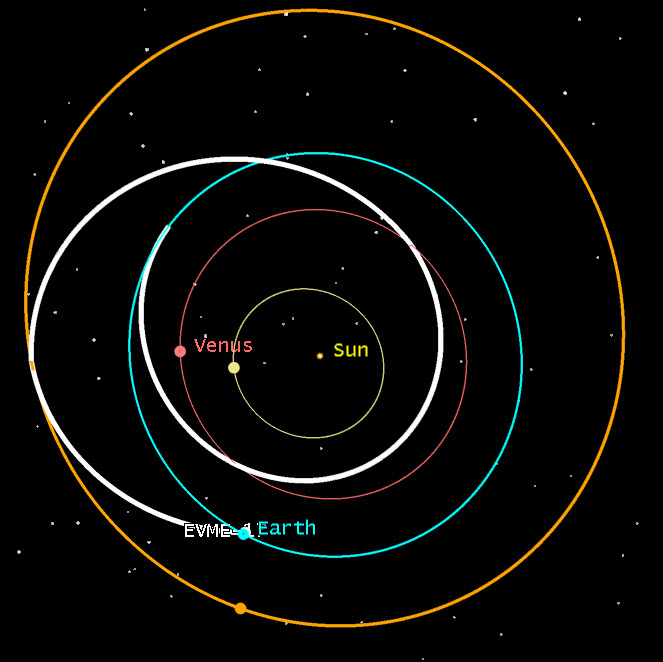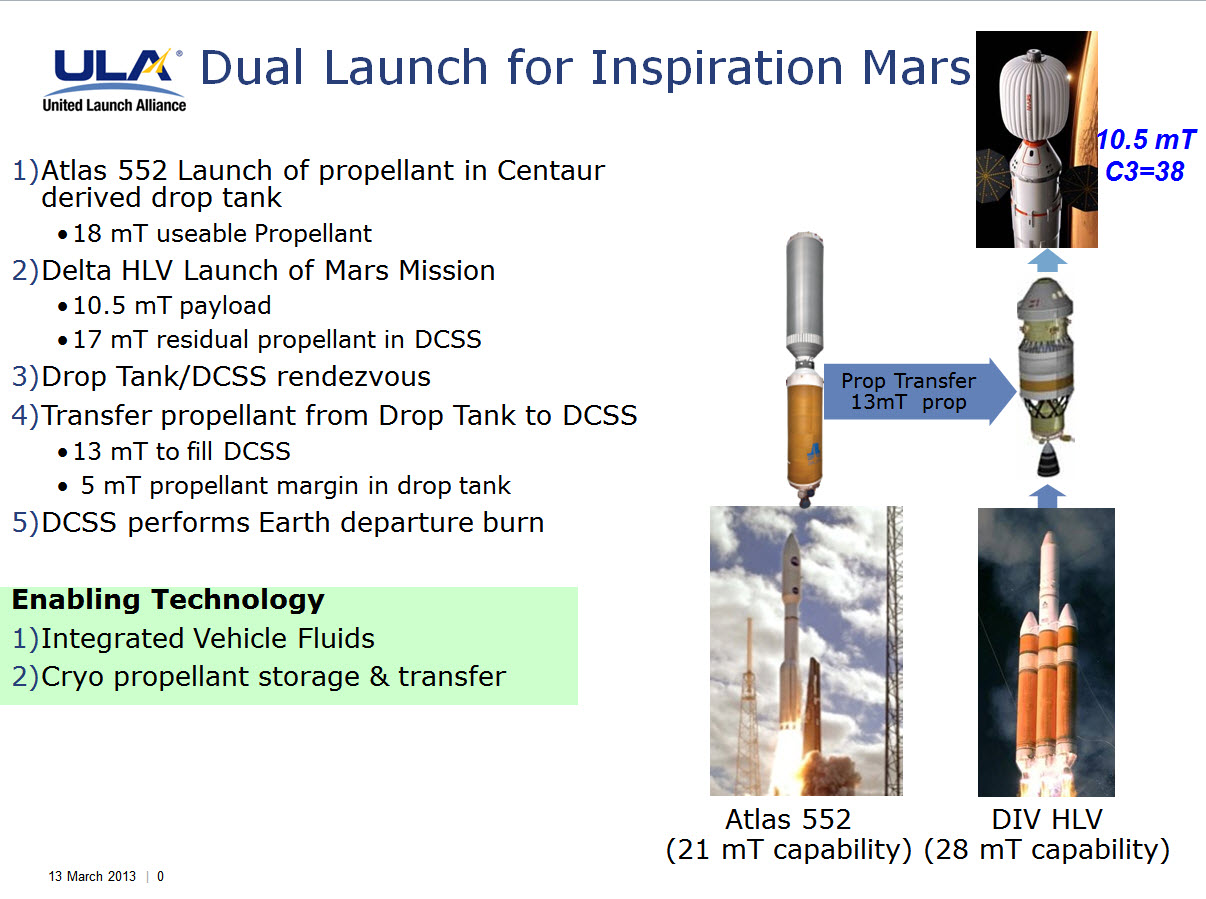by Astrogator Mike | Mar 24, 2013 | General Comments
We put together a quick video using our current model:
The model was created by our friends priestmangoode in the UK. They put together the capsule/panels/inflatable model for us, and then our friends at Analytical Graphics Inc. , makers of the STK software, cleaned up the model for us a bit and added a DCSS upper stage (reflecting one of our current design options).
The video was created in STK, and put together in Imovie. Music again provided by Astrogator_Mike’s brother, Allan Loucks and comes from his “Point Defiance” score.
Don’t read too much into the spacecraft attitude at this point, I just did something easy and made the long axis follow the Mars-centered velocity direction.
by Astrogator Mike | Mar 13, 2013 | General Comments
By Mike Loucks, John Carrico and Dennis Tito
Dennis Wingo provided some comments for us in his article
Inspiration Mars: Some Thoughts About Their Plan. Dennis Wingo is a friend of ours. We welcome input from any source, especially visionaries like Dennis.
Our IEEE Paper is an attempt to show the feasibility of the simplest possible Mars flyby mission. We chose a simple Mars flyby trajectory (the one from the Patel reference), and will choose a simple ECLSS, heat shield, etc., using existing designs and technologies on a single launch. We may eventually deviate from these assumptions, but only when we have proven that we must.
The paper is not an attempt to flush out every feasible technology that could be made available in the next 5 years nor does it contain all analysis that has been done by the Inspiration Mars team.
Our paper represents the work-in-progress that had been done when the paper’s deadline for peer-review came. We added additional details for the IEEE conference last week, and more will come out in the following weeks. We intend for our process to be open and public, and invite input from all sources.
We have a very experienced and savvy trajectory team, and we are aware of most of the technologies and trajectory options available. We explored those options when they were relevant, dismissed some that we felt were not, and left others for analysis at a later date.
We offer the following responses to some of Wingo’s specific points.
1. Precise targeting of Aerocapture
Our analysis of re-entry is currently incomplete. We have bounded the problem, but our current analysis does not allow us to assess injection accuracy requirements. If we do require unusually high-precision targeting, we believe that such targeting can be achieved. It might be hard, but targeting in deep space is hard. We will have a long time to adjust our trajectory on the way back to Earth, with the full resources of Earth ground systems available to help us get it right. We will team with whatever NASA experts are available to help solve these problems (JPL, JSC, etc.) in the same fashion that we have already teamed with NASA/Ames.
2. Required Volume not available in inflatable until inflated:
This is a solvable problem. The paper didn’t cover it, but our engineers have several options available that were not discussed in the paper.
3. EVME Trajectory from 2002 Okutsu/Longuski Paper
The trajectory from the 2002 paper by Okutsu and Longuski Mars Free Returns via Gravity Assist From Venus, requires a launch 10 months earlier than our nominal. We have simulated this and many other similar trajectories. This trajectory travels well inside of the orbit of Venus, down to 0.56 AU. (the orbit of Venus is approximately 0.7 AU). The departure C3 for this trajectory is better than our nominal, but the re-entry velocity is essentially identical. The excessive thermal and schedule requirements of this mission eliminated it from consideration.

2017 Earth-Venus-Mars-Earth Trajectory (At Earth Arrival)

Baseline 2018 Inspiration Mars Free Return Trajectory (At Earth Arrival)
4. AeroGravity Assist.
Wingo mentions trajectories from a paper by Bonfiglio, Longuski, and Vinh,
Automated Design of Aerogravity Assist Trajectories. These trajectories require lift to drag (L/D) ratios not available with any of the capsules we are considering (the Apollo capsule had L/D ~0.38, Dragon or CST-100 will be similar). Table 5 from the reference lists L/D values between 1 and 7. Our vehicle will have a capsule with an upper stage and an inflatable module still attached when it encounters Mars. It is not feasible for this configuration to have the L/D characteristics required for Aerogravity Assist maneuvers. This technique was not considered.
5. EVME Trajectory from Foster and Daniels paper.
Wingo also mentions a trajectory from the paper by Foster and Daniels, Mission Opportunities for Human Exploration of Nearby Planetary Bodies This trajectory is another flavor of the solution from the 2002 Okutsu/Longuski paper within the same launch window, only optimized for minimal departure C3 by using a deep-space burn. The deep space burn is another strike against this mission, in addition to the thermal and schedule issues mentioned previously. It was not considered due to these issues.
6. Lunar flyby.
While a Lunar Flyby could be used to save Delta-V, it would require modifications to any currently available upper stage. These stages are designed for quick use in Earth orbit, and don’t have the ability (currently) to last more than a few hours after launch. A Lunar flyby trajectory would require the upper stage to first execute a TLI maneuver, then several TCM maneuvers, and finally a powered swingby at the Moon to achieve TMI. This would involve intense early operations, modifications to the upper stage, and a powered swingby of the Moon. While we are certainly capable of planning such trajectories, we currently are not considering this option as part of the baseline.
7. Falcon Heavy performance
SpaceX confirmed our C3 curves from the IEEE paper in several conversations and thus the single launch option on the Falcon Heavy was our baseline for that document. We are currently considering the Falcon Heavy as well as several other launch options, including the ULA 2-launch option shown below.

Inspiration Mars ULA 2-Launch Option (Courtesy of ULA)
This option is similar to those being explored by Golden Spike (Mike and Taber are both Golden Spike board members).
We are also considering an SLS/DCSS option.
Our current desire is still to fly the simplest option; one with the fewest possible launches, one single swingby, no deep space burns (other than Trajectory Correction Maneuvers), and no lunar swingbys.
We have several backup trajectories and launch strategies in case any of these assumptions must be revisited.
Our goal is to stick with the simplest mission plan and make that work.
Links to the Baseline Inspiration Mars trajectory:
Inspiration Mars Baseline trajectory in the NASA/Ames Trajectory Browser
Created by Cyrus Foster. (The dates are slightly different here, but it’s the same opportunity).
Inspiration Mars Trajectory VDF file
You will need the free STK Viewer App, which you can get from AGI here , to view the file. You can also view it directly in STK.
Inspiration Mars Ephemeris file
Time-stamped (Julian Date) cartesian J2000 vectors every hour, in the Earth-Centered Equator and Equinox of J2000 coordinate frame.
And of course, The Inspiration Mars Animation
by Astrogator Mike | Mar 8, 2013 | General Comments
After some Jedi tricks from Tom Mann of Applied Defense Solutions, the Astrogator’s Guild blog is back and running. More posts soon, but for now we give you the Inspiration Mars trajectory, brought to you by both of us (and Mike’s brother Al with the Music).
The video was made with Analytical Graphics Inc.‘s software called “Systems Tool Kit” (formerly known as Satellite Tool Kit) using the Astrogator Module.
The optimized trajectory was created first using MAnE from SpaceFlight Solutions
The clips from STK were put together on a Mac using Imovie. Music clips provided from Al Loucks’ personal music archive. If you listen carefully you’ll recognize the music from the “Lobster Alice” clip found on Al’s Demo Page


